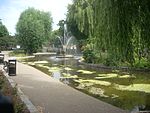BSix Sixth Form College
2002 establishments in EnglandAC with 0 elementsClapton, LondonEducation in the London Borough of HackneyEducational institutions established in 2002 ... and 1 more
Sixth form colleges in London
BSix Sixth Form College: Brooke House is a sixth form college located in Upper Clapton, London, England. It was established in 2002, giving students in Hackney the opportunity to study at a college close to where they live. Brooke House has previously been the site of other educational institutions.
Excerpt from the Wikipedia article BSix Sixth Form College (License: CC BY-SA 3.0, Authors).BSix Sixth Form College
Kenninghall Road, London Clapton (London Borough of Hackney)
Geographical coordinates (GPS) Address Phone number Website External links Nearby Places Show on map
Geographical coordinates (GPS)
| Latitude | Longitude |
|---|---|
| N 51.5592 ° | E -0.0569 ° |
Address
BSix Sixth Form College (The Brooke House Sixth Form College)
Kenninghall Road
E5 8BP London, Clapton (London Borough of Hackney)
England, United Kingdom
Open on Google Maps







